Blair Tourograph & Dry Plate Co.,
Boston, MA
Combination Camera
Variation 1.5 (rigid platform) -
A Craftsman Alteration of Variation 2.0
4 x 5"
Bottom
Top Label, bottom of front
standard
Close-up of Fine-Focus Mechanism - photo of rear of platform facing
toward the front of the camera.
This camera, like most Blair view camera
models, has rack and pinion focus. The racks on which the camera
rests nickel plated and can be seen on the left and right of the photo
below.
Date Introduced: - ;
Years Manufactured: c.1882-1883 The
Combination part of the
name Combination Camera referred to the ability to have two plate sizes in a small package
due to the Blair
Blair Patent
Extension pieces. Both the
Blair Combination Camera Variation 1.0
and the Blair Combination Camera Variation 2.0
are known from Blair catalogs, both with and without a
Blair Patent
Extension attached. The camera
above, here called the Blair Combination Camera Variation 1.5
has the rack and pinion focus that is the hallmark of
Variation 2.0. But
it has a non-folding bed, which is never mentioned as an option for
either the Variation 1.0 or Variation 2.0 Combination Camera.
Because of this rather fundamental difference, it was given its own
variation: Variation 1.5, which makes it easier to discuss, despite, as
I shall show below, that this camera is not a Blair design,
Non-Folding
Platform: Since the non-folding platform is central to
the existence of Variation 1.5, it is essential to thoroughly describe
its appearance as a substitute to the provenance that a catalog might
provide. The platform is made of mahogany, as are the platforms of
Variation 1.0 and Variation 2.0. It is a simple frame, as are the
hinged rear sections of the two folding platform variations. It
does not have a center brace as do the hinged front sections of the two
folding platform variations, and therefore does not have a provision for
tripod attachment - decidedly rare in a view camera of this era of long
exposures. The corner joints of the Variation 1.5 platform are
exactly as you would find in the platforms of the other two variations,
i.e., each corner is a bridle joint, which can be thought of as
an extended tongue in groove for a corner. It is not an easy joint
to be made without the tools and jigs available in a camera factory.
I should know, as I have attempted them (see
Semmendinger Platform
Reproduction Part 3).
The platform is nine inches long, at least
two inches longer than the rear section of a 4x5" format Variation 1.0.
It also has a wider front edge to which to attach the front
standard, whereas the front edge of the rear sections of the folding
variations is the same dimensions as the other three edges. The
two Nickel-plated brass rack parts of the rack and pinion focus appear
to be identical to those seen on the other two variations. The
width of the non-folding platform is exactly the same as for the 4x5"
format example of Variation 1.0 - but then, it would have to be in order
for the pinion shaft of the rack and pinion to properly engage.
The long edges of the platform appear to be very like the edges of the
other variations, at least as far as can be judged given that wood is
missing from both sides. These features in this paragraph suggest
that the non-folding platform could have been made by Blair, as a lost
trial design or a special order, but not as merely the back end of a
Blair camera. But there are other characteristics that suggest
otherwise.
The bottom of the platform shows three holes for relatively large wood
screws with which to secure the front standard. Indeed, two of
these have screws and do fufill that purpose, but the third hole is
empty since putting a screw there would miss the front standard
entirely. This suggests that the platform was made for a different
and thicker front standard than the Blair one currently in place.
Additionally, the last photo above, showing the rear of the platform,
discloses that the dimensions of the bridle joints were marked using
shallow knife marks prior to cutting them. This is a standard
cabinet-maker procedure used before sawing joints (usually dove tail
joints) by hand. These marks prove that the joints were cut by
hand, not using jigs such as a factory would. Therefore, it
appears that the non-folding platform of Variation 1.5 is a craftsman
product (a very excellent craftsman) onto which the top of a Combination
Camera Variation 2.0 has been put. The extra hole at the
front for a screw that cannot engage the front standard is a mystery. Ground Glass Back
The ground glass back currently present, despite its lighter color, is
the original back of the camera. However, it slides in like one of
the plate holders, rather than hinging down as it originally was made.
Combination Cameras Variation 1.0 and Variation 2.0 both have side hinges, each
side affixed to the ground glass frame by two screws and to the rear
standard by a single screw which acts as the hinge. The original
holes in the ground glass frame and rear standard have been neatly
filled, probably when the alterations were made to the platform,
To make a functional non-hinged back, two large brass springs have been
screwed into the rear standard, and the nickel-plated clip at the top
middle of the rear standard has been very neatly trimmed of its rear
part, which formerly would have held up the hinged ground glass frame
and the normal plate holder. The plate holders that now fit are
the ones used in the Blair Hawkeye (Detective-type) cameras.
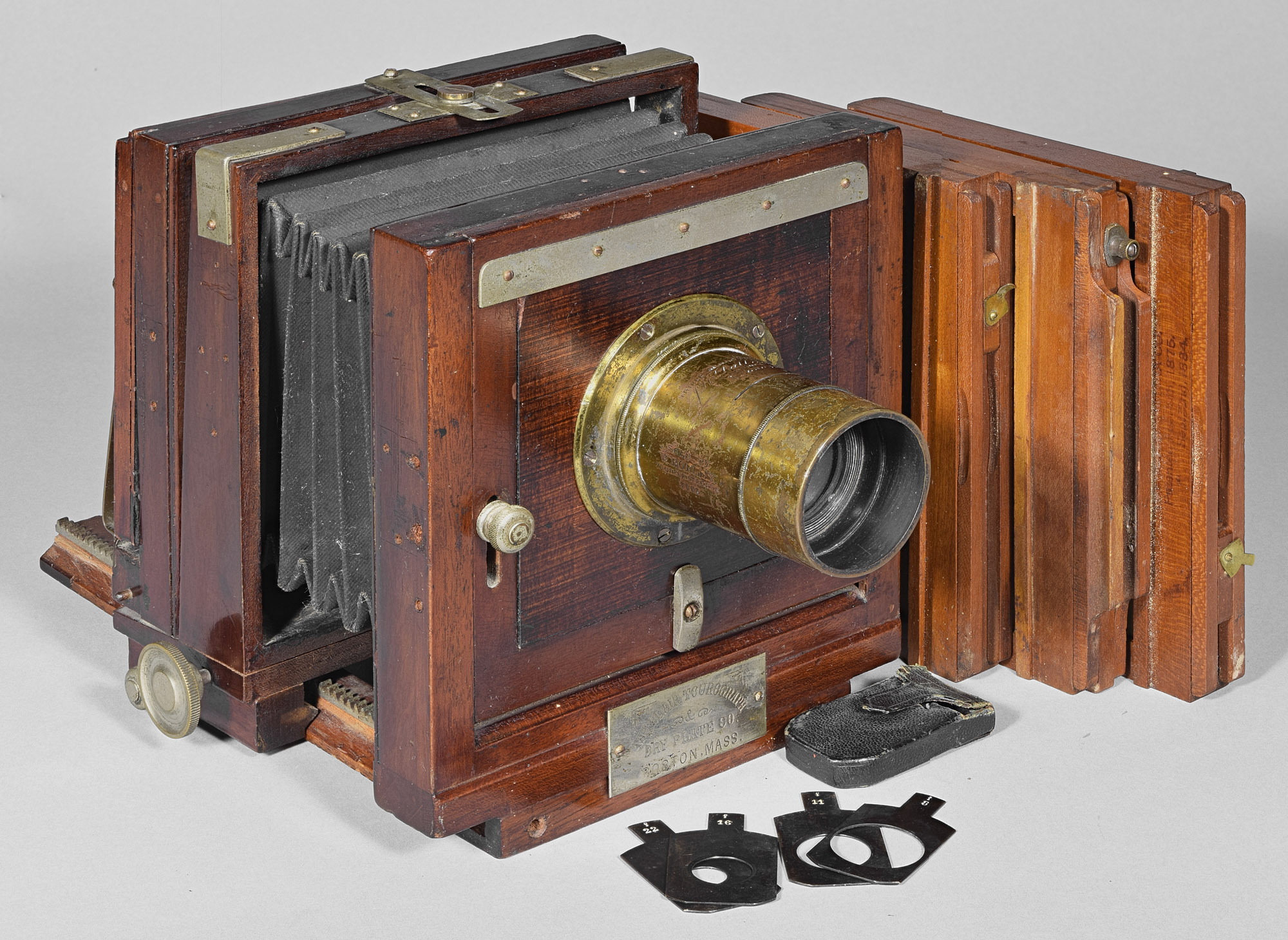
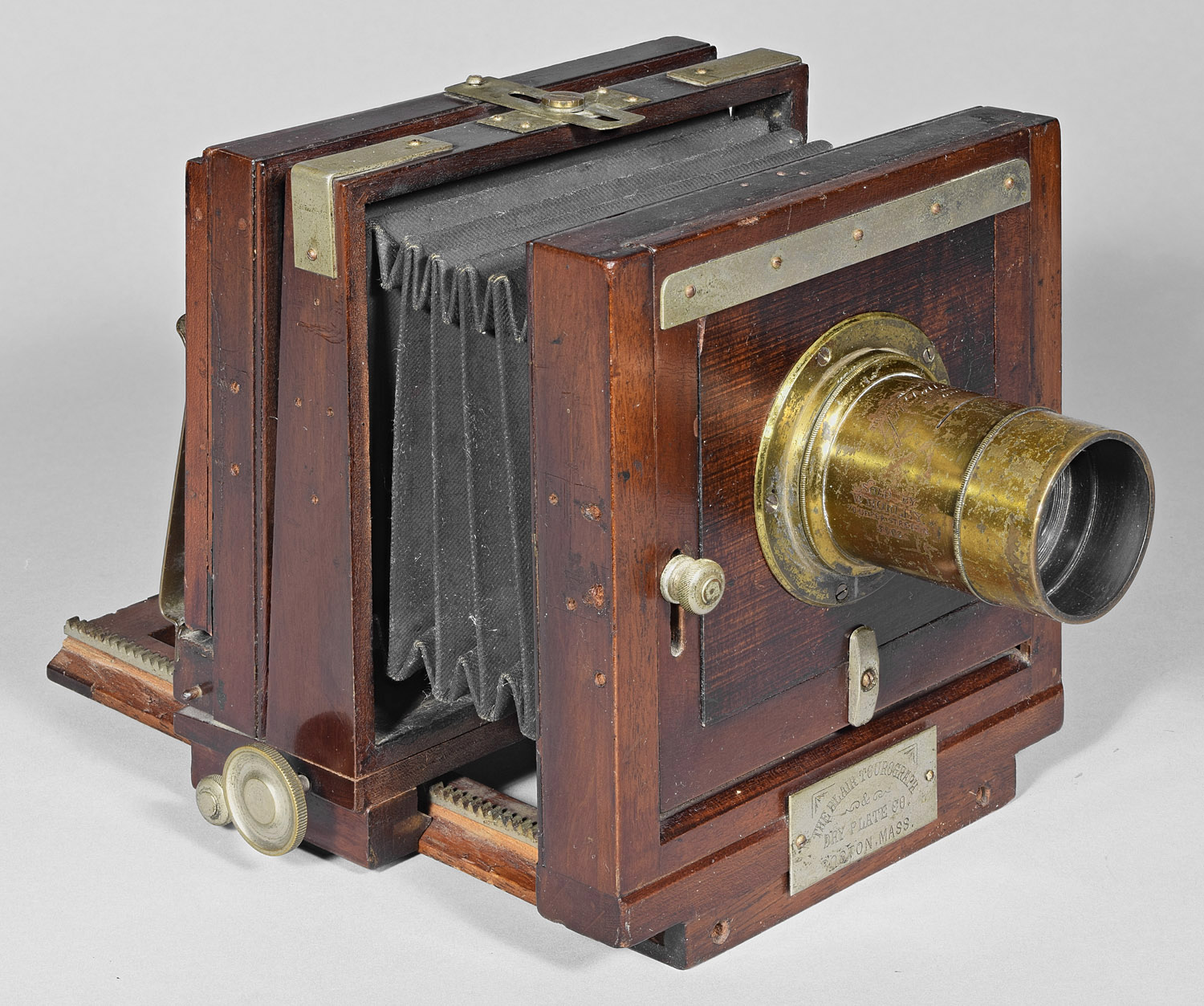
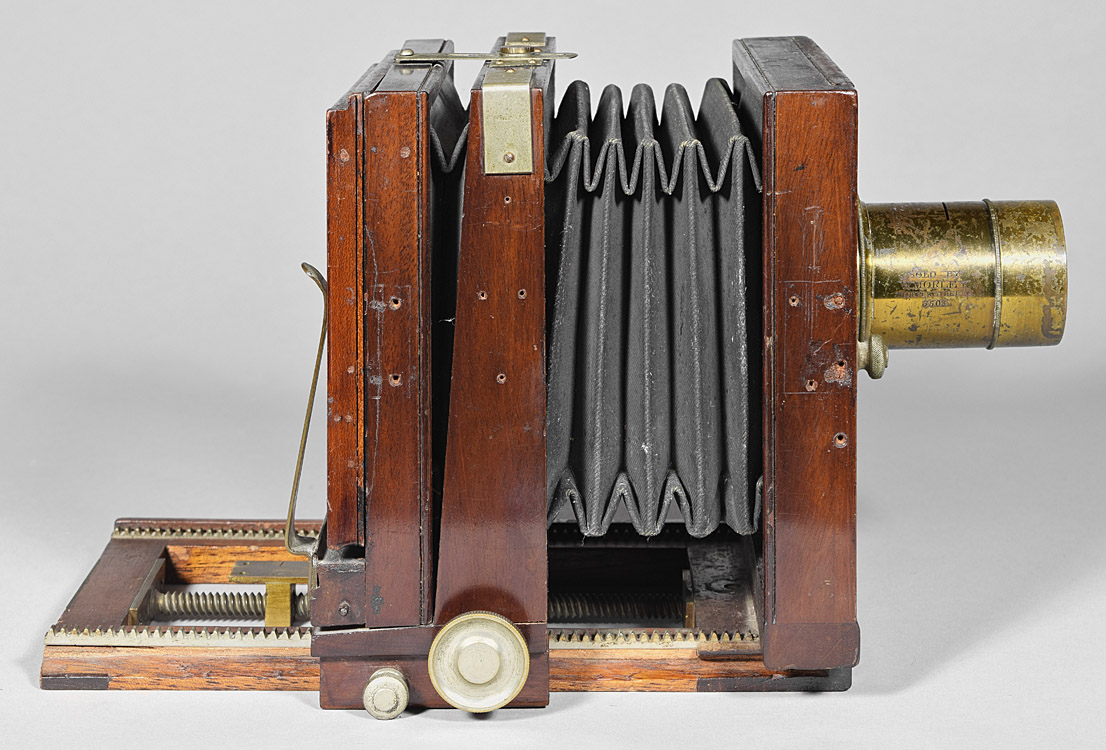
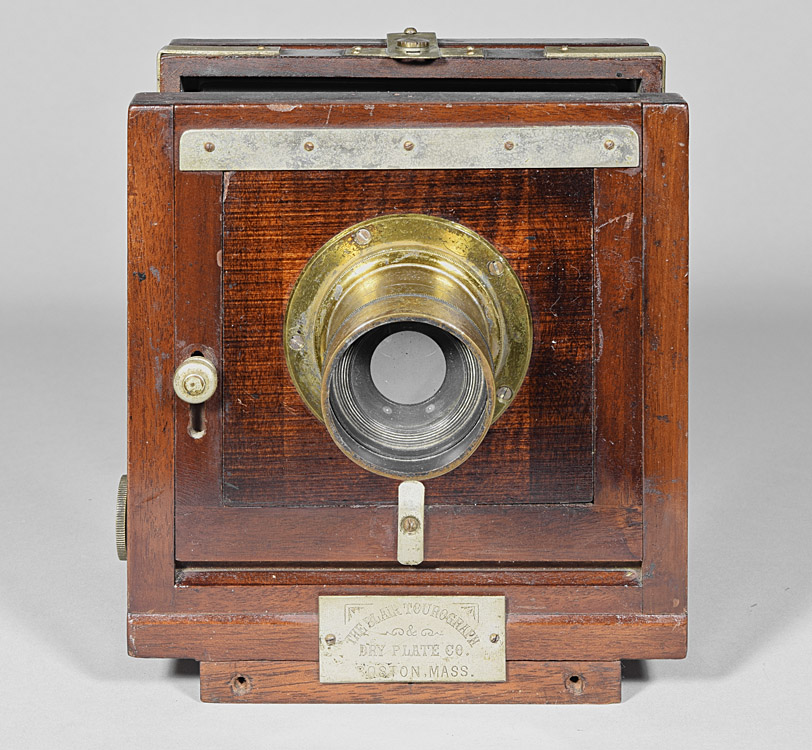
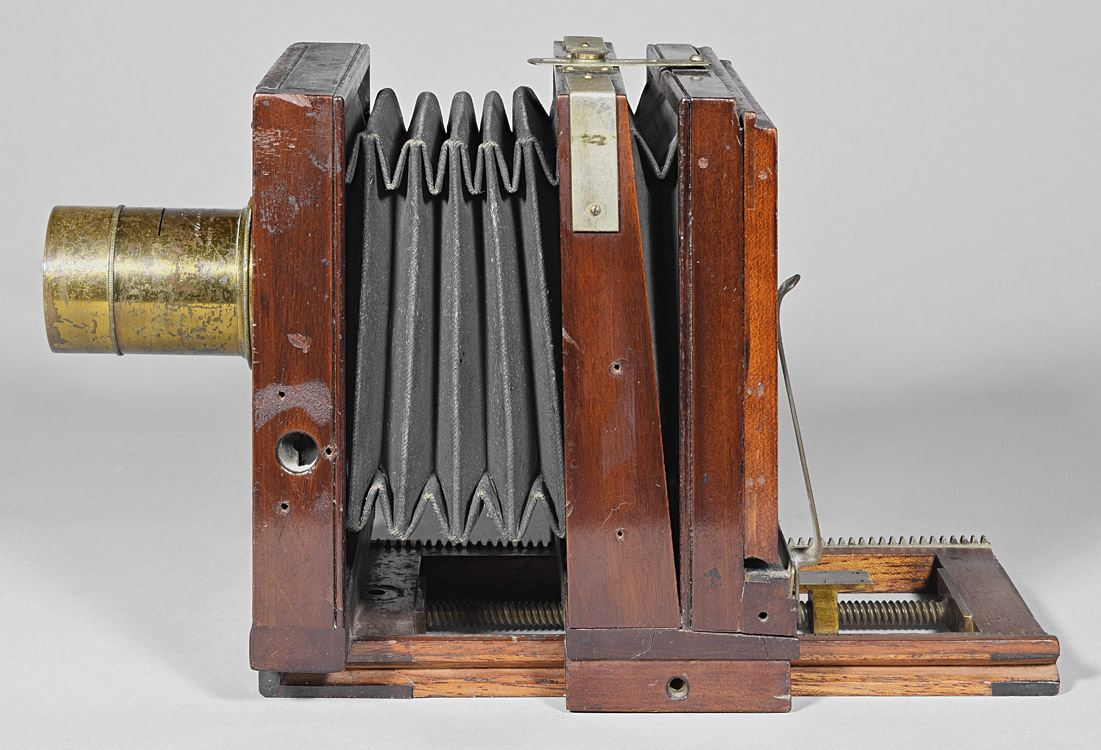
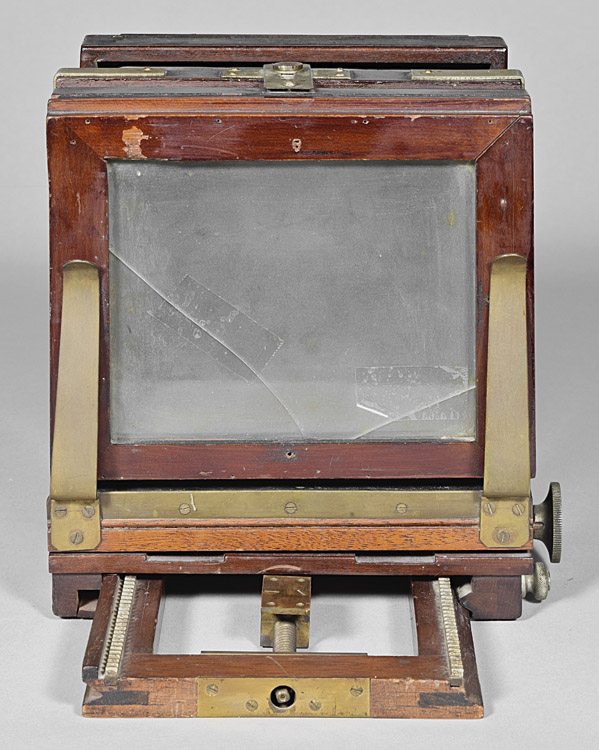
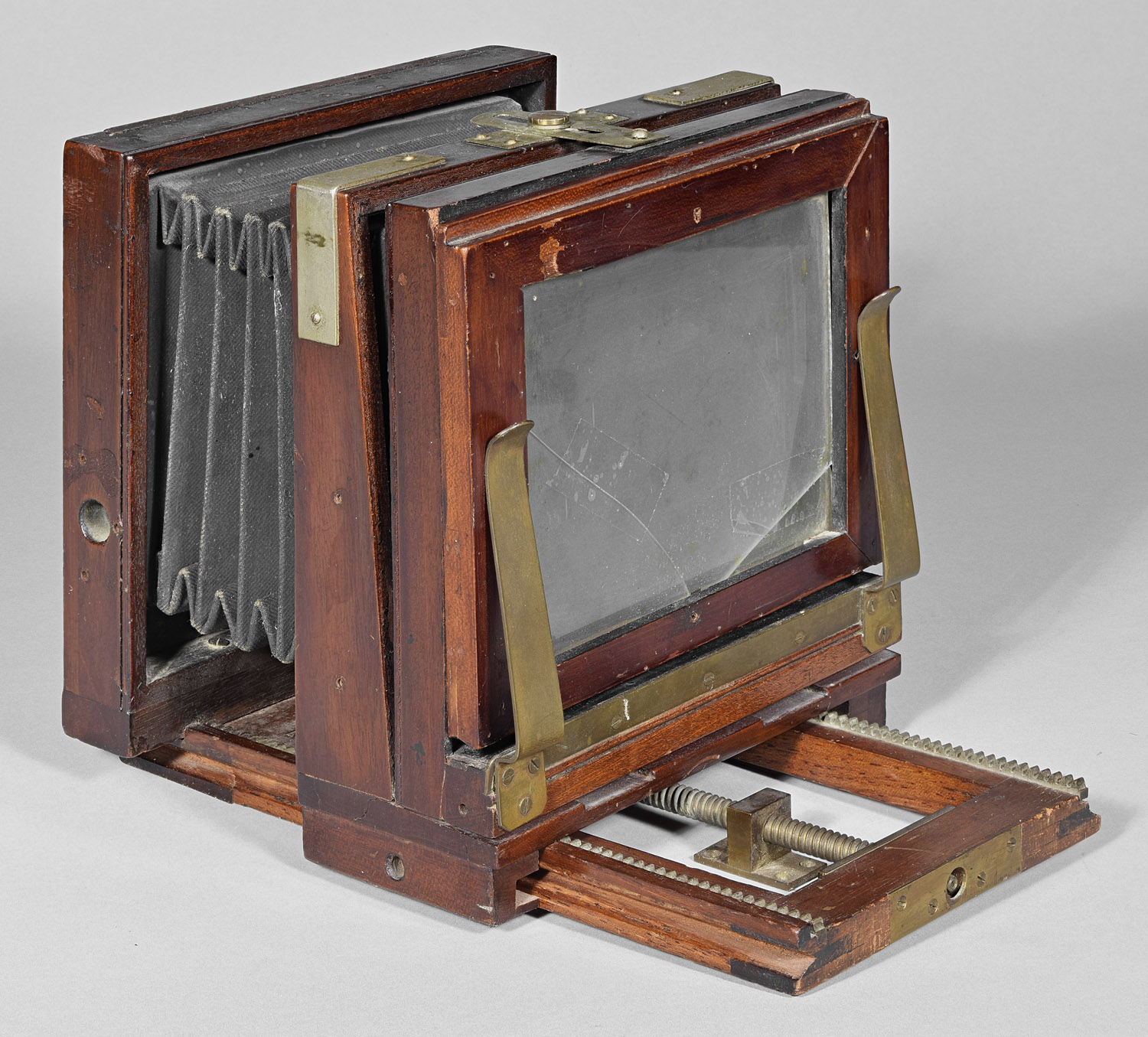
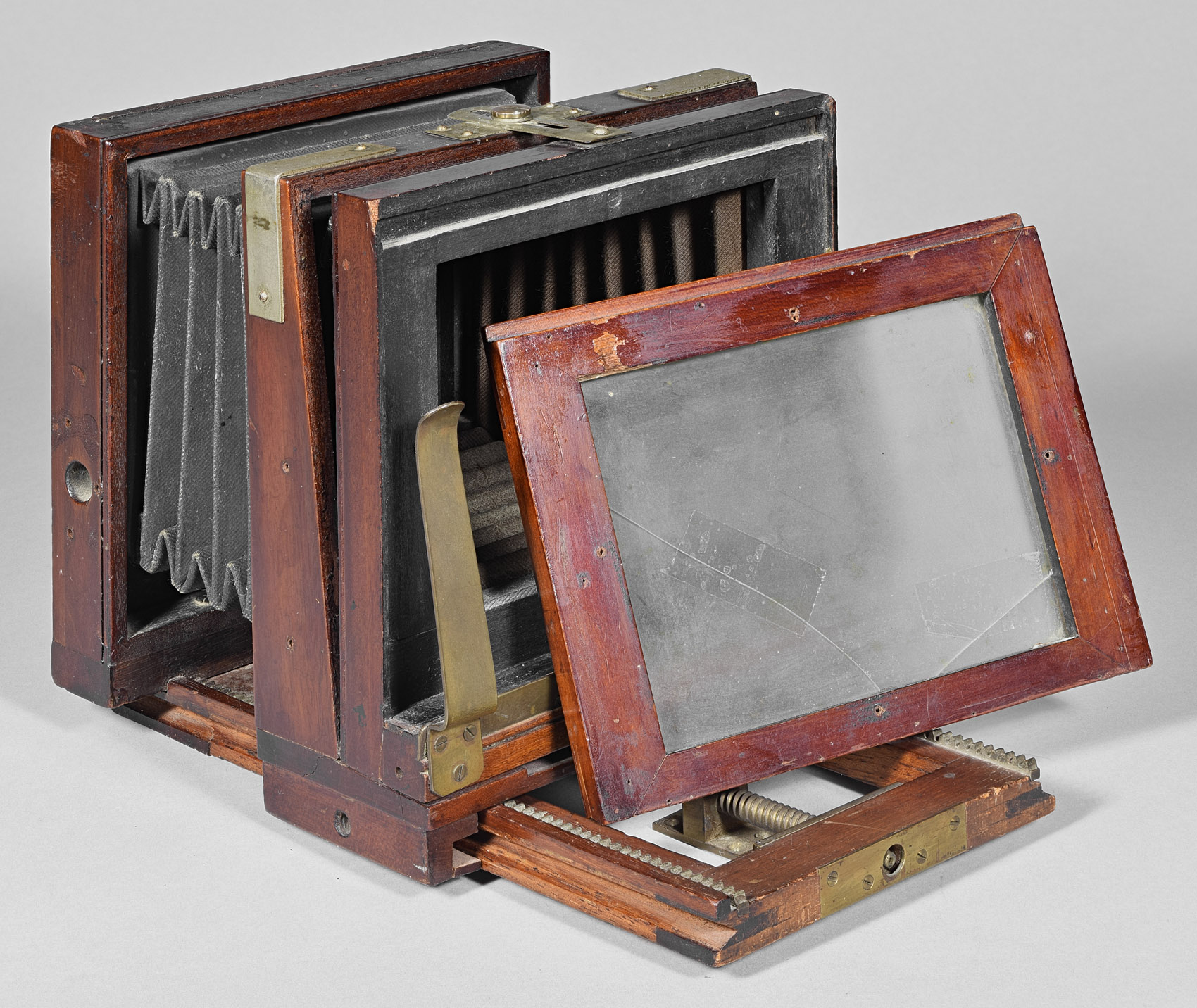
A threaded rod runs the length of the camera platform, meant to provide
fine focus. The brass fitting left of center had at one point been
screwed at two different spots into the bottom of the rear standard.
It is now loose since it does not freely turn. Besides, the
redundant focus, rack and pinon, is the equivalent of fine focus anyway.
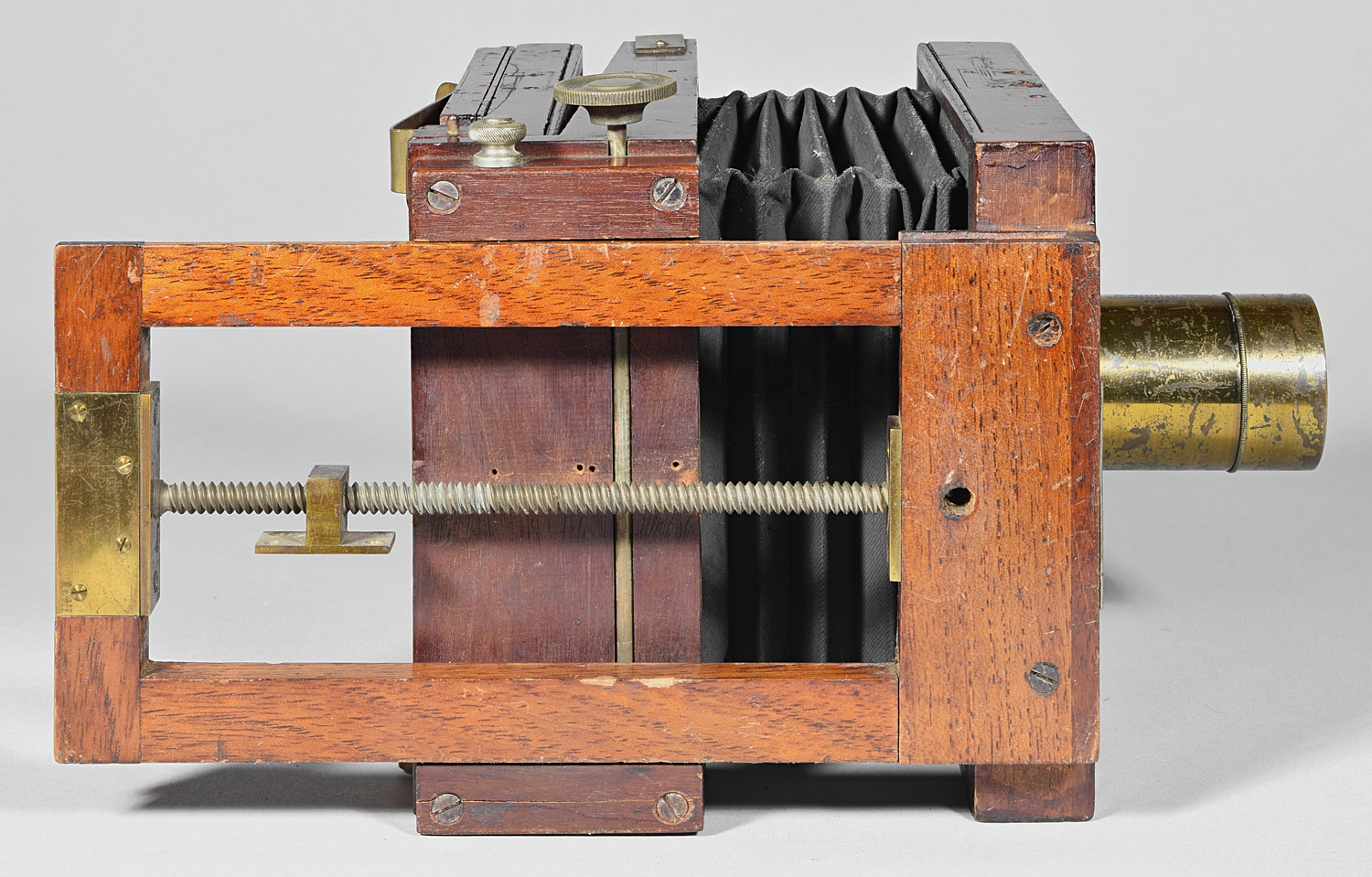
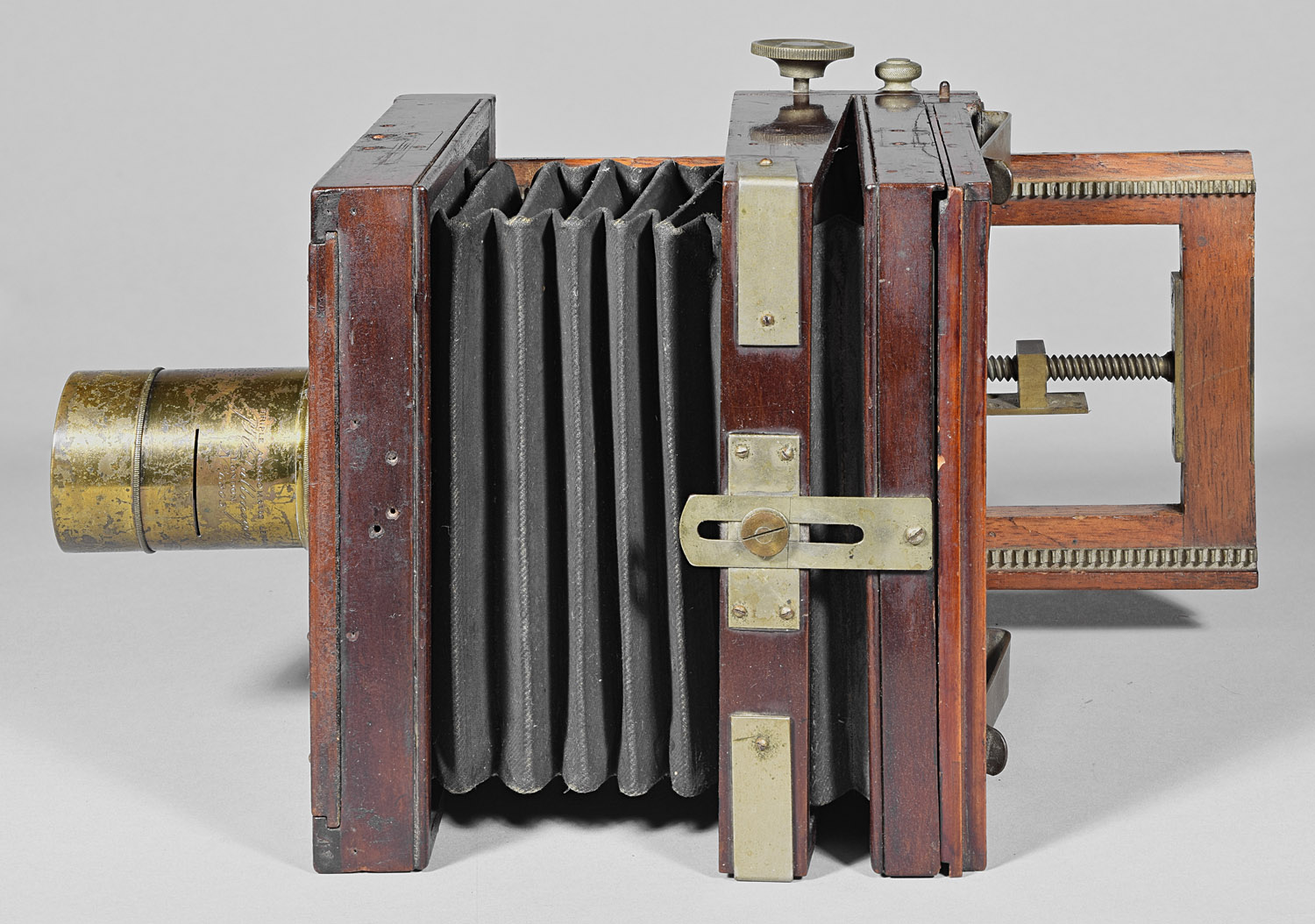

In addition, a 1/4" diameter slanted screw thread has
been installed at the center of the platform, going the entire length
from rear to front. A square brass fitting is threaded onto the
screw (seen near the top of the photo). This fitting would be
attached to the underside of the rear standard by screws that fit
through the four holes visible on the upper surface of the fitting.
A key fitting onto the square projection at the very end of the platform
(near the bottom of the photo) could be turned, which would slowly move
the rear standard in either direction. The installation is quite
well don, including the inletting of the brass plate at the back of the
platform as well as the neat hole in it, not to mention an ~9" long
coarse threaded brass rod. The threads are similar to those found
in fine focus screws of early view cameras made by E. & H.T. Anthony &
Co. and Scovill/American Optical Co, but normal fine focus screws are
only a couple of inches long. Oddly, the only Blair model to have
such a fine focus screw is the Blair Utility
View Camera, which, although longer than a couple of inches, is
a normal bolt thread and not slanted.
The perfectly functioning rack and pinion focus on this
camera makes this central fine focus redundant at best. The key
has been lost and the square brass fitting has been detached. That
the components are composed of bare rather than Ni-plated brass
probably means that it was installed after market.
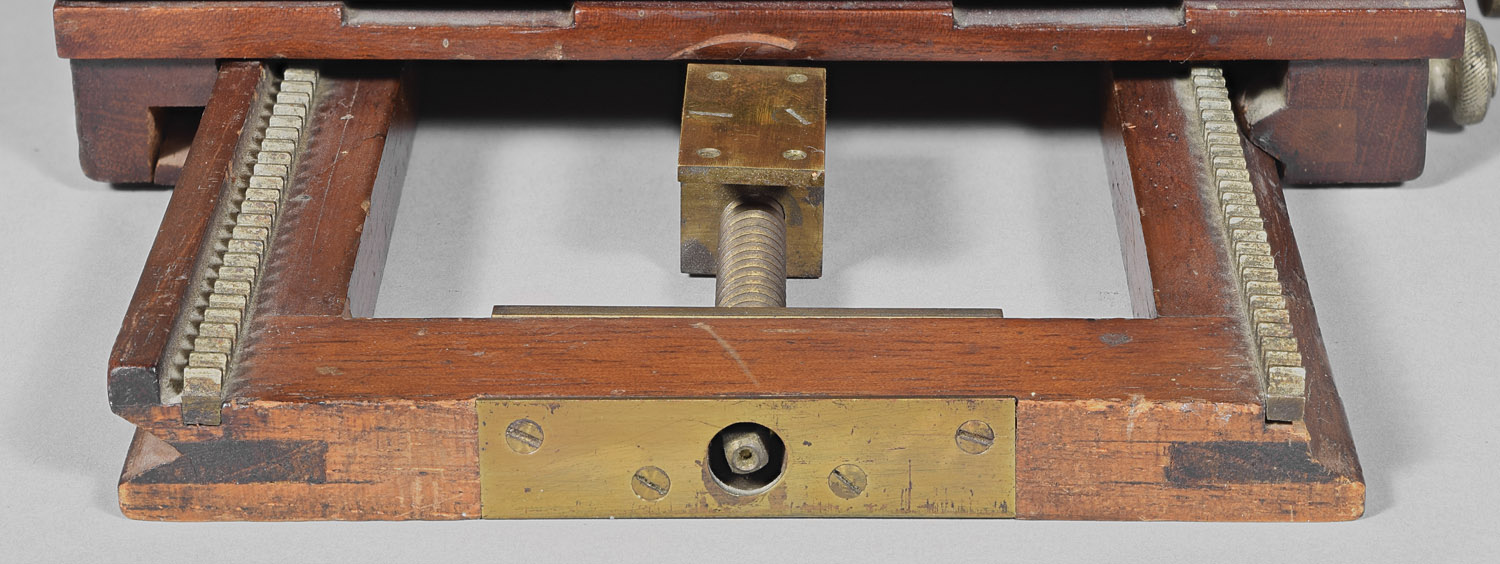
Construction: rear
focus via push-pull; single swing or double
swing (5x8 only); reverse by two tripod mounts; three-piece lens board
Materials: mahogany body; cherry base;
black fabric bellows; nickeled hardware
Sizes Offered: 1530=4x5 w/ 5x8 extension;
1531=5x8A w/ 6½x8½ or 8x10 extension; 1532=5x8B w/ 6½x8½ or 8x10
extension
Notes:
References:
